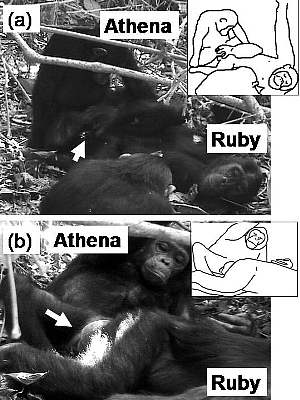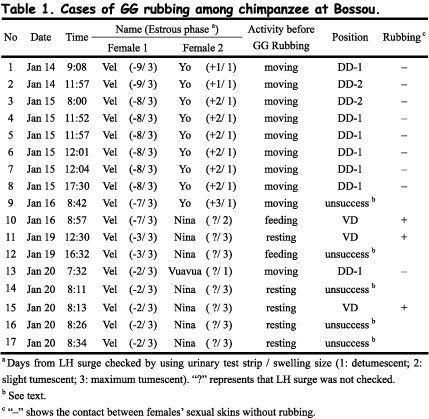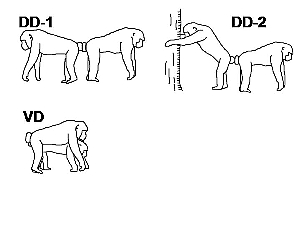|
Genito-genital rubbing among the chimpanzees of Mahale and Bossou.
Koichiro Zamma¹, Shiho Fujita² ²Faculty of Applied Biological Sciences, Gifu University Introduction Genito-genital (GG) rubbing, which is known as one of the unique behaviors of bilias (bonobo: Pan paniscus), has the following characteristics: two females assume a ventro-vental or ventro-dorsal position and the younger female thrusts her pelvis (Yerkes Regional Primate Research Center, Atlanta1), or two females embrace ventro-ventrally and rub each other's sexual skin together (Wanba, Republic of Zaire2, 3). In captivity, chimpanzees (Pan troglodytes) were also observed to perform GG rubbing, but the variety of positions they exhibited were different from those exhibited by bilias4. Among wild chimpanzees, we observed GG rubbing at the Mahale Mountains National Park, Tanzania and Bossou, Guinea. Here, we present the first description of GG rubbing by wild chimpanzees. Methods Behavioral observations were conducted from August to November 2003 at Mahale by KZ and from December 2001 to March 2002 at Bossou by SF. KZ followed one of nine focal chimpanzees (P. t. schweinfurthii) on each day and recorded their body contacts with other chimpanzees. SF followed one of four focal females (P. t. verus) on each day and recorded their social interactions. Observations Case 1: GG rubbing of Mahale chimpanzees On September 14, 2003, KZ followed a 7-year-old female named Athena. Her small sexual skin had not shown swelling. At 11:09:38, when Athena was resting on the ground, Ruby, an adult female with swollen sexual skin, approached and lay laterally behind Athena. Then Athena mounted Ruby and shook her hip against Ruby's sexual skin (but Athena's sexual skin did not touch Ruby's) and groomed Ruby. At 11:10:23, after Athena shook her hip again, she slightly stood up and rubbed her sexual skin against Ruby's on a front-back axis (Position 1, Fig. 1a). At 11:10:51, Athena lay on her back and rubbed her sexual skin against Ruby's (Position 2, Fig. 1b). Ruby did not shake her hip, but detached it slightly from Athena's. Athena also inspected the sexual skin of Ruby by gazing at it and licking it. KZ observed Position 1 once and Position 2 twice.
In spite of the infrequency of this behavior, five positions of GG rubbing were observed. Among bilias, the ventro-vental position was reported as a typical one1, 2, while among captive chimpanzees, the ventro-vental, ventro-dorsal and dorso-dorsal positions, as well as the ventro-dorsal-like position where the mountee lay on her side, were reported4). Among wild chimpanzees, we did not observe the ventro-vental position but did observe the dorso-dorsal position, in which a female stood in a bipedal position with the support of a tree trunk (DD-2). Five hypotheses on the function of GG rubbing have been proposed: reconciliation, mate attraction, tension regulation, expression of social status, and social bonding5. The small amount of data from our observations precludes the possibility of testing these hypotheses exhaustively, but our results do suggest that GG rubbing did not occur to release tension. In our observations, GG rubbing occurred when chimpanzees were resting (3/3 in Case 1 and 2/12 in Case 2) and moving (9/12 in Case 2) but rarely occurred during feeding (1/12 in Case 2). In addition, no conflict was observed among the chimpanzees engaged in this behavior. It is still unclear whether GG rubbing provides a mechanism to attract mates. When Vel and Nina engaged in GG rubbing (No. 15 in the table), the alpha male of the group disturbed their GG rubbing by shaking a branch at a distance, which, however, did not result in heterosexual copulation. Because Nina kept trying to engage in GG rubbing with Vel (No. 16 and 17) after the male's intervention, Nina appeared to have more interest in GG rubbing with Vel than in copulation with the male. Anestis4 indicated that GG rubbing could occur with higher probability as the degree of bonding between female chimpanzees was higher. In Case 2, GG rubbing occurred in particular pairs, including a mother and her daughter, among 9 adult females of the group; these pairs had high affinity in the party composition6. The data supported the hypothesis that GG rubbing reinforces or at least reflects social bonds.
Interest in another female's swollen sexual skin might cause GG rubbing among wild chimpanzees. In Case 1, Athena gazed and licked the swollen sexual skin of Ruby. Another time, Athena was also observed to investigate her own sexual skin. Athena might perform GG-rubbing to simultaneously fulfill both her interest in the other's swollen sexual skin and her interest in her own immature sexual skin. In Case 2, Vel was involved in all interactions and reached maximum swelling when she GG-rubbed. The initiator of GG rubbing might be interested in the swollen sexual skin of the recipient (Vel) and thus act upon her interest by rubbing her own sexual skin against that of the recipient (Vel).
Back to Contents |


